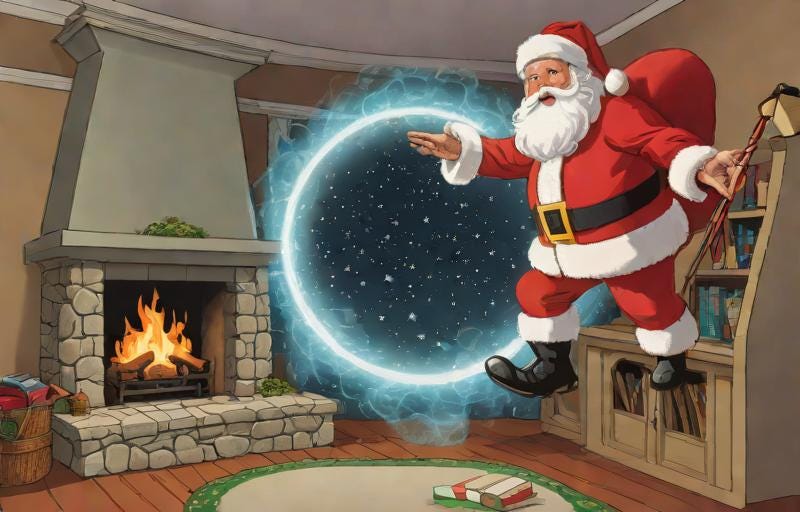
Over on ex-Twitter, Martin Bauer reposted an old thread about the quantum mechanics of Santa Claus, which is pretty amusing. But, of course, it’s only one of the great pillars of 20th century physics, so I had to counter with a version based on the other, namely General Relativity: the Spacetime Santa model. And because it’s that kind of morning, and Christmas only comes once a year, and all that, I’ll type out a prose version of that here.
The core problem of Santa Claus in physics is, of course, one of scale. Bauer has it expressed reasonably compactly:
As he correctly notes, this is exceedingly implausible if Santa also has to travel by flying sleigh from each house to the next. So he proposes a quantum approach in which all the houses are simultaneously visited by a quantum Claus. This raises some problematic issues when it comes to measurement theory, though, in that one child observing the distribution in progress could collapse the whole thing.
The alternative picture I’d like to propose draws on the key insight of Einstein’s relativity as interpreted by Minkowski, namely that space and time are not separable concepts. We live in a four-dimensional spacetime, with time merely another coordinate on equal footing with the three dimensions of space. The entire concept of simultaneity is relative: what one observer sees as two events at different positions happening at the same time will be seen as two events at different moments according to a second observer moving relative to the first, or at a different distance from a massive object.
Furthermore, work dating all the way back to Einstein and Rosen in the 1930s has shown that points in spacetime can be connected together in non-trivial ways, through structures popularly known as “wormholes.” These are usually discussed as “shortcuts through space,” but crucially, they connect points in spacetime, and the time element cannot be neglected. It is possible, verging on inevitable, that a wormhole with one endpoint in, say, Hawkins, IN with the other at, say, the North Pole will also connect different dates.
And this is the key to the Spacetime Santa model. The distribution of gifts on Christmas Eve is simultaneous only in the frame of the recipients: to Santa and his team, the delivery events originate on different days of the year. Santa enters a traversable wormhole at the North Pole on, say, March 10th, and emerges in the fireplace of a suburban house in, say, Trelew (the one in Cornwall, mind) at a few seconds past midnight on December 25 of the previous year.
This addresses both the travel issue (Santa is not, in fact, flying through the atmosphere risking incineration from air resistance) and the timing issue (instead of a mere 31 hours of darkness in which to distribute gifts, has had more than 300 days in which to make deliveries). It also explains the otherwise mysterious tradition of entrance via the chimney: the fireplace is a location where a person (child or adult) is highly unlikely to be standing in the wee hours of Christmas morning, making it a safe location for a wormhole mouth.
To be sure, even in the Spacetime Santa model there is a role for quantum physics. Obviously, the construction of traversable wormholes requires a detailed understanding of quantum gravity (using the famous Brand-Cooper technique). And the optimal distribution of the endpoints is something that can only be worked out with the aid of a sophisticated quantum computer.
Anyway, I think the evidence is clear that this is a powerful model explaining how Santa Claus is able to deliver gifts to all the celebrating children in a single night: it only looks like a single night to the kids; to Santa and company, it’s a year-round operation. Somebody needs to give me a massive research grant to work out the further implications of this highly sophisticated and totally scientific theory.
A very Merry Christmas to those who celebrate, or will at least not object to being wished well on a holiday they don’t celebrate. The rest of you, have a lovely Monday. If you liked this, here’s a button:
And if you want to call out any of the ovoids associated with the other principal Christian holiday that I put in this, the comments will be open:





"It is possible, verging on inevitable, that a wormhole with one endpoint in, say, Hawkins, IN with the other at, say, the North Pole will also connect different dates."
I am curious; my layman understanding (or representation) was that indeed you were travelling in time as much as space? Like, if you were to travel from A to the North Pole, it'd take you 6 months. A wormhole 'cuts' on the distance 'because' it 'adjusts' time i.e., you think you've arrived to the North Pole instantaneously (and maybe you have, as far as you're concerned) but the world around you is older by... well, maybe 6 months, maybe less, no idea how the physics stuff works.
What do you think of the above as a way to get your head around a wormhole for a non physics person?